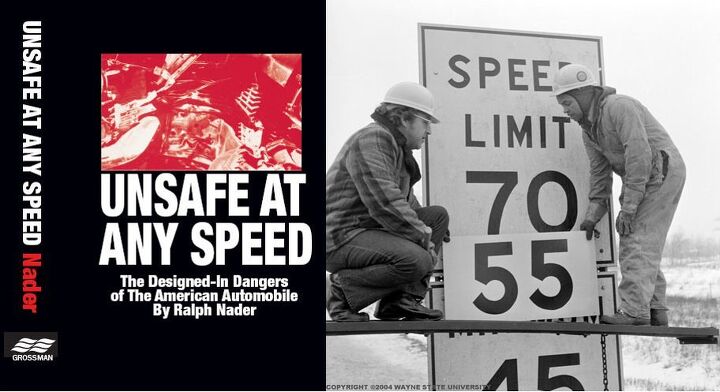Two Coincidental Anniversaries: Nader's 'Unsafe At Any Speed' Turns 50, 30 Years After National Speed Limit Abolished

On Nov. 29, 1995, having lost Congress to the Republicans in the 1994 midterm elections, President Bill Clinton reluctantly signed a transportation bill that repealed the National Maximum Speed Limit of 55 miles per hour. The NMSL was made law in 1973, during the Nixon administration, in response to the oil embargo and energy crisis that followed in the wake of the Yom Kippur War. While it didn’t precisely mandate a national 55 mph limit, the law allowed the federal government to withhold highway funds from states that didn’t lower expressway speed limits to 55, the so-called “double nickel.”
It just so happened that the next day was the 30th anniversary of the publication of Ralph Nader’s highly influential book about car safety, “Unsafe At Any Speed.”
One of Nader’s prime targets was the rear-engined and swing-axled Chevrolet Corvair, which had some inherent stability issues that GM decided to fix with unequal tire pressures front and back instead of using a more sophisticated and more costly hardware fix.
GM also made the mistake of hiring a private investigator to snoop on Nader, who later sued and won. The lawsuit and large award (if memory serves me well, it was $500,000 when that was very serious money) made Nader a public figure to this day.
Upon Clinton’s signature that allowed speed limits to rise, Nader said in 1995 that “President Clinton is about to join the Congress in supporting legislation that his own Department of Transportation says will kill and injure tens of thousands more Americans on the highways every year and cost the nation more than $19 billion a year.”
President Richard Nixon signed legislation that forced a national 55 MPH Speed Limit into law, but unfortunately my “search fu” has failed me and I cannot find an appropriate photo. Pres. Jimmy Carter was an enthusiastic supporter.
After the NMSL was enacted, highway fatality rates indeed went down. Part of that may have been due to lower speeds, but it was also possibly due to people driving fewer miles, though larger trends were likely involved.
Expressway fatality rates had been going down for decades, since the 1940s. Consequently, traffic death rates went down after the 55 mph limit was enacted, but they also went down after the repeal of that same 55 mph limit, contrary to Nader’s dire predictions of more carnage on the roads. In fact, highway fatality rates went down quicker in those states that raised their highway speed limits than in those states that kept the limit at 55.
While it undoubtedly saved gasoline and diesel fuel, at the cost of many, many hours of time that could have been devoted to other, more productive things, it’s not entirely clear how many lives were saved by the NMSL. It did help grow the consumer electronics industry as truckers embraced CB radios as a means of avoiding “Smokey” and car enthusiasts started using radar detectors.
Feel free to discuss Ralph Nader, the 55 mile per hour speed limit, or any combination of the two.
Ronnie Schreiber edits Cars In Depth, a realistic perspective on cars & car culture and the original 3D car site. If you found this post worthwhile, you can get a parallax view at Cars In Depth. If the 3D thing freaks you out, don’t worry, all the photo and video players in use at the site have mono options. Thanks for reading – RJS

Ronnie Schreiber edits Cars In Depth, the original 3D car site.
More by Ronnie Schreiber
Latest Car Reviews
Read moreLatest Product Reviews
Read moreRecent Comments
- Jkross22 When I think about products that I buy that are of the highest quality or are of great value, I have no idea if they are made as a whole or in parts by unionized employees. As a customer, that's really all I care about. When I think about services I receive from unionized and non-unionized employees, it varies from C- to F levels of service. Will unionizing make the cars better or worse?
- Namesakeone I think it's the age old conundrum: Every company (or industry) wants every other one to pay its workers well; well-paid workers make great customers. But nobody wants to pay their own workers well; that would eat into profits. So instead of what Henry Ford (the first) did over a century ago, we will have a lot of companies copying Nike in the 1980s: third-world employees (with a few highly-paid celebrity athlete endorsers) selling overpriced products to upper-middle-class Americans (with a few urban street youths willing to literally kill for that product), until there are no more upper-middle-class Americans left.
- ToolGuy I was challenged by Tim's incisive opinion, but thankfully Jeff's multiple vanilla truisms have set me straight. Or something. 😉
- ChristianWimmer The body kit modifications ruined it for me.
- ToolGuy "I have my stance -- I won't prejudice the commentariat by sharing it."• Like Tim, I have my opinion and it is perfect and above reproach (as long as I keep it to myself). I would hate to share it with the world and risk having someone critique it. LOL.




































Comments
Join the conversation
You glossed over Sammy Hagar's contribution...
Can't speak for individual states, but I know that here in Ontario, safety advocates and the Minitry of Transportation point out that deaths dropped after the speed limit was reduced. This is countered by groups like stop100.ca with the fact they passed mandatory seatbelt legislation at the same time as reducing the speed limit. We are still stuck at 100km/h here (62mph), but it is rarely enforced. To the point that except for rush hour, when the traffic reports talk about the "normal travel time" (i.e. at the speed limit) between various points, the current average is always less.